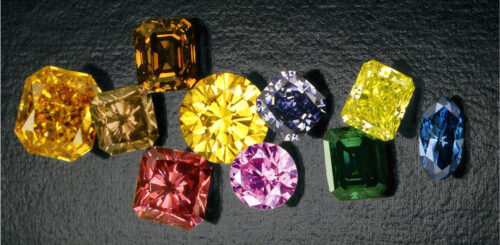There are billions of carbon atoms in a 1 carat diamond. All these atoms must be carbon in order to create a colourless diamond. The slightest deviation will lead to a coloured diamond. For example, boron atoms will make a diamond blue and nitrogen atoms will make a diamond yellow. Then again, pink and red tones are caused by changes in the electronic structure where the diamond is pushed upwards from the deepest layers in the earth.
In laboratories, it is possible to create coloured diamonds whereby the natural occurrences are simulated. The colour of natural diamonds can also be improved artificially. For example, irradiation may give a diamond a yellow or brown tint. At BNT Diamonds however, we only work with 100% natural and untreated diamonds.
GIA describes the colour of “Fancy colored” diamonds in 3 ways: through the shade (pure spectral colours of the diamond), the tone (brightness of the shade) and the saturation (strength of the colour on a scale from neutral to vivid). Natural radiation for example creates a more intense colour.
Red diamonds
Red is more or less the rarest diamond colour. Red diamonds are therefore the most expensive. Red tones are caused by a change in the electronic structure during the formation of the diamond.
Yellow and orange diamonds
Yellow diamonds are not so rare. Diamonds with the most vivid colour can be found in South Africa. The yellow and orange shades are created by the presence of nitrogen. Nitrogen atoms are very similar to carbon atoms and easily take their place during the formation process of diamonds.
Green diamonds
Also green diamonds are extremely rare, only 10 per year are found. Some green diamonds have traces of nickel. However, most green diamonds arise from the natural radiation of nearby rocks. Since the colour green is often only seen in the outer layer of the stone, a part of the colour gets lost by polishing it.
Black diamonds
In contrast to the formation of other coloured diamonds, the black colour is not related to the atoms in a diamond. Small inclusions of graphite and iron lead to black shades. This ensures that black diamonds are opaque, in contrast to all other transparent coloured diamonds. Because of these inclusions, a black diamond breaks more easily than other diamonds. Also, they often degrade during processing and some can only be used for industrial purposes.
BNT Diamonds informs and advises potential investors about the appropriate investment diamonds. Through this link, you can read about how to choose a coloured diamond as an investment.
More information about investing in diamonds:



